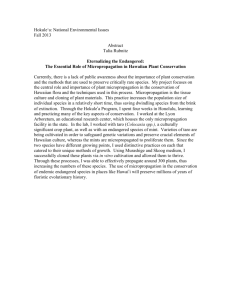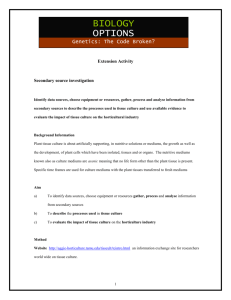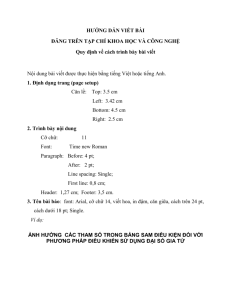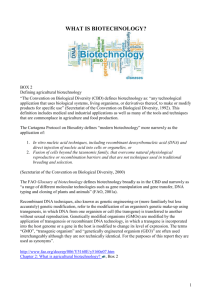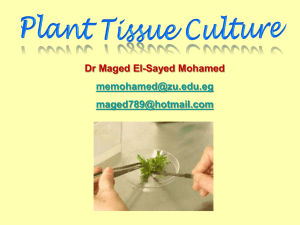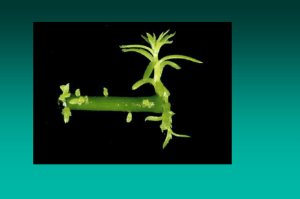Template in MS Word format
advertisement
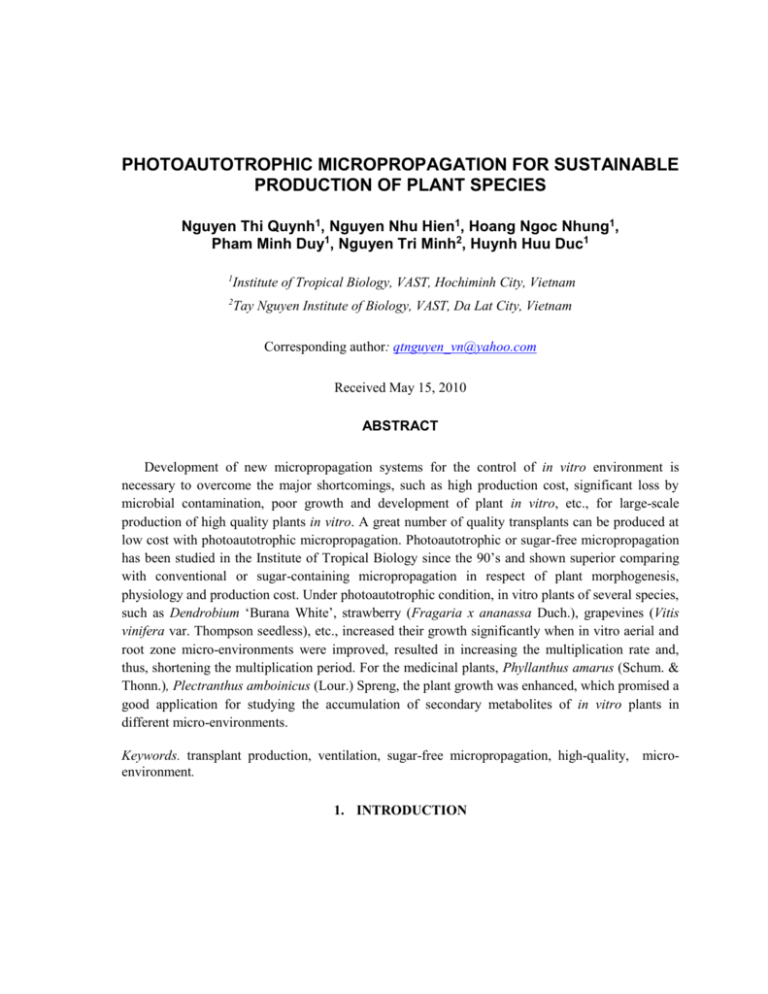
PHOTOAUTOTROPHIC MICROPROPAGATION FOR SUSTAINABLE PRODUCTION OF PLANT SPECIES Nguyen Thi Quynh1, Nguyen Nhu Hien1, Hoang Ngoc Nhung1, Pham Minh Duy1, Nguyen Tri Minh2, Huynh Huu Duc1 1 Institute of Tropical Biology, VAST, Hochiminh City, Vietnam 2 Tay Nguyen Institute of Biology, VAST, Da Lat City, Vietnam Corresponding author: qtnguyen_vn@yahoo.com Received May 15, 2010 ABSTRACT Development of new micropropagation systems for the control of in vitro environment is necessary to overcome the major shortcomings, such as high production cost, significant loss by microbial contamination, poor growth and development of plant in vitro, etc., for large-scale production of high quality plants in vitro. A great number of quality transplants can be produced at low cost with photoautotrophic micropropagation. Photoautotrophic or sugar-free micropropagation has been studied in the Institute of Tropical Biology since the 90’s and shown superior comparing with conventional or sugar-containing micropropagation in respect of plant morphogenesis, physiology and production cost. Under photoautotrophic condition, in vitro plants of several species, such as Dendrobium ‘Burana White’, strawberry (Fragaria x ananassa Duch.), grapevines (Vitis vinifera var. Thompson seedless), etc., increased their growth significantly when in vitro aerial and root zone micro-environments were improved, resulted in increasing the multiplication rate and, thus, shortening the multiplication period. For the medicinal plants, Phyllanthus amarus (Schum. & Thonn.), Plectranthus amboinicus (Lour.) Spreng, the plant growth was enhanced, which promised a good application for studying the accumulation of secondary metabolites of in vitro plants in different micro-environments. Keywords. transplant production, ventilation, sugar-free micropropagation, high-quality, microenvironment. 1. INTRODUCTION Transplant production based on micropropagation methods has advantages over transplant production using seeds or cuttings with respect to genetic and phenotypic uniformity, enormous multiplication rate and scheduled-year-round production of disease-free or pathogen-free transplants. However, the reduction of production costs for micropropagation of many plant species was not as rapid as expected. The reasons for the high production cost of plants in vitro by conventional (heterotrophic or photomixotrophic) micropropagation are: (1) a significant loss of plants in vitro by microbial contamination at the multiplication stage, (2) poor growth and development of plants in vitro, (3) poor rooting partly due to callus formation at the plant base and thus, (4) excessive loss of these plants after transplanting in the greenhouse or field, (5) high overor under-production of plants in vitro. Development of photoautotrophic (no sugar in the culture medium) micropropagation systems for the control of in vitro environment is necessary to overcome the major shortcomings as described earlier for large-scale production of high quality plants in vitro. The concept of photoautotrophic micropropagation was introduced as a means of reducing production cost and automation/robotization of the process. The main reason for high production costs in conventional micropropagation is the presence of organic carbon sources, such as sucrose and vitamins, in the culture medium [1]. The presence of these sources causes significant loss of plants in vitro by microbial contamination during the multiplication stage and, thus, increases the labor cost for cleaning. In photoautotrophic micropropagation, the sucrose is reduced or completely eliminated from the medium, while the photosynthetic photon flux (PPF) and the carbon dioxide concentration during the photoperiod are increased. Reduction of relative humidity and ethylene concentration in the vessel will promote the transpiration and the mineral uptake, and improve physiological and morphological characteristics of plants in vitro, respectively. In addition, plants in vitro are proved to grow better when gelling agent such as agar or Gelrite is replaced by air porous supporting material such as vermiculite or cellulose fibers, which improves rooting of plants in vitro by increasing oxygen or nutrient availability in the root zone environment. Since increasing the light intensity alone cannot raise the net photosynthetic rate for in vitro plants at their CO2 compensation point, the increase in CO2 concentration and, thus, the decrease in relative humidity and ethylene concentration in the vessel can be achieved either by natural or forced ventilation. The study on photoautotrophic micropropagation of several plant species has been carried out at the Institute of Tropical Biology since the year 2000. In this paper, we show some results from the photoautotrophic growth of strawberry (Fragaria x ananassa Duch.), Dendrobium 'Burana White', grapevines (Vitis vinifera), Phyllanthus amarus (Schum. & Thonn.), Plectranthus amboinicus (Lour.) Spreng, as affected by different PPFs, CO2 and ventilation conditions. 2. MATERIALS AND METHODS 2.1. Natural ventilation system using small culture vessels under different sucrose concentration, CO2 concentration, PPF and supporting material conditions For natural ventilation, microporous gas-permeable filter discs are attached on the hole of the lid or sidewalls of relatively small culture vessels like Magenta GA-7 with an air volume of 300 400 ml. The number of air exchanges or natural ventilation rate, of an airtight Magenta-type vessel is about 0.15-0.2 h-1, while it varies from about 2 to 4 h-1 or more if the vessel is attached by one, two or three microporous gas-permeable filter discs (10 mm in diameter each) with a pore-diameter of 0.45 µm [2]. As gas-permeable filter discs are currently rather expensive, and its high price is restricting the commercialization of photoautotrophic micropropagation, clean white papers for printing or writing letters, or plastic bags with paper filters attached against the walls have been recently used, which proves a good application of the new method in the micropropagation industry. 2.2. Forced ventilation systems with large culture vessels The CO2 concentration and other gaseous concentrations in the culture vessel with natural ventilation are interrelated with a number of factors such as the metabolic activity of the plants in vitro, the plant size and leaf area, the number of air exchanges of the culture vessel and the culture room environment. Thus, the gaseous concentrations in the culture vessel with natural ventilation are often unpredictable and uncontrollable in large-scale production using large numbers of small culture vessels. Furthermore, it is difficult to provide a high number of air exchanges for a large culture vessel [5].This drawback can be overcome by the forced ventilation method, in which CO2 concentration and air movement inside the vessel can be increased by flushing a particular gas mixture directly to the vessel, using an air pump or an air compressor, and, thus, ventilation rate can be easily controlled using an airflow controller [6, 7]. The advantage of this method is that a large culture vessel, which can accommodate thousands of in vitro plants, can be used for commercial mass micropropagation [8]. The ambient air of the culture room, containing CO2 of aimbien atmosphere, was pumped into the inlet of a Bio-Safe Carrier box (Nalge Co., U.S.A.) through a microporous filter disc (φ = 50 mm) with pore size of 0.22 μm (Millipore, Tokyo, Japan) using an air pump (15 Watt, Model EP-9000, RAMBO Co., Taiwan). The volume of the box is 7 L. On day 5, the beginning day of using air pump, the flow rate was set at 0.3 l mim-1, which is equivalent to 2.6 h-1 when expressed by number of air exchanges, then gradually increased every 5 - 6 days using air flow controllers (Model RK 1150, Kofloc Co., Japan) in order to maintain CO2 concentration measured at the vessel outlet as equal as the ambient CO2, around 350 - 400 μmol mol-1. The number of air exchanges in the forced ventilation experiment of Dendrobium was estimated to be 13.7 h-1 on day 35, whereas, in the forced ventilation of grapevines, the number of air exchanges was estimated at 7.4 h-1 on day 35. PPF applied to this experiment was 30 μmol m-2 s-1 on day 0 and was increased gradually during the culture period. Perlite or vermiculite (150 g per box) was used as supporting material with. Fifty explants were cultured into the large box or five explants into the Magenta-box (11.5 x 102 explants m-2) for forced or natural ventilation treatments, respectively. All cultures were kept at 25 1oC room air temperature, 65 5% relative humidity and 12 h d-1 photoperiod period. 3. RESULTS AND DISCUSSION 3.1. Dendrobium ‘Burana White’ Effect of different ventilation rates, 3.5 or 4.9 h-1, and light intensities, 50, 80 or 110 μmol m-2 s , on photoautotrophic growth of Dendrobium ‘Burana White’ were determined after 65 days of culture. In vitro plants grown photoautotrophically in the natural ventilation under PPF of 110 μmol -1 m-2 s-1 and in the vessel having high ventilation rate (4.9 h-1) showed the highest increase in fresh and dry weights on day 65 (Fig. 1). Plants cultured in the treatment of low PPF (50 μmol m-2 s-1) and low ventilation rate (3.5 h-1) showed significantly lower chlorophyll a/b ratio (1.7) than those (2.4 and 2.5) in the other treatments. 3.2. Strawberry (Fragaria x ananassa Duch.) Strawberry plants in vitro grew better in a natural ventilation system under photoautotrophic condition than photomixotrophic condition. The porous supporting material also promoted the growth in both photomixotrophic and photoautotrophic conditions. The higher CO2 concentration (1000 mol mol-1) and PPF (150 mol m-2 s-1) increased the plant growth significantly when compared with ambient CO2 concentration (400 mol mol-1) and lower PPF (100 mol m-2 s-1). Furthermore, plants derived from photoautotrophic micropropagation produced more runners, which were preferred as explant source for propagation in the greenhouse, and within a shorter period than those of conventional micropropagation (Fig. 2). a A B Figure 2. (A) Strawberry plants grew photoautotrophically under different PPFs and CO 2 concentration in natural ventilation condition on day 28. For treatment codes, L and H in the left represent 400 µmol mol-1 or 1000 µmol mol-1 CO2 concentration, respectively; L and H in the right represent PPF of 100 or 150 μmol m -2 s-1, respectively. (B) Strawberry plants derived from the treatment HH grew in the ex vitro condition on day 28 4. CONCLUDING REMARKS In the near future, photoautotrophic or sugar-free micropropagation will be commonly used, especially in developing countries, for producing a large number of genetically superior and pathogen-free transplants at low production cost. At the same time, the photoautotrophic micropropagation system will be adopted on a large scale as a useful means for solving the global st problems of environmental conservation, food production and bio-resource production in the 21 century. Photoautotrophic micropropagation can be done either by using small, conventional culture vessels with gas permeable filters for enhancing natural ventilation or large culture vessels with air pumps for forced ventilation. The use of plastic bags attached paper filters for photoautotrophic micropropagation is a good application in the country like Vietnam. Acknowledgement. The studies received the supports from DOST (Hochiminh City, Vietnam) from 2007-present, the Southern National Key Laboratory for Plant Cell Technology (Vietnam) for basic research from 2006-present, IABA (Japan) from 2001-2008. REFERENCES 1. Kozai T. - Automation in Biotechnology, Elsevier Science Publishers B.V., the Netherlands, 1991, pp. 279-304. 2. Kozai T., Zimmerman R. H., Kitaya Y., and Fujiwara K. - Environmental Effects and their Control in Plant Tissue Culture, Acta Hort. 393 (1995) 230. 3. Murashige T. and Skoog F. - A revised medium for rapid growth and bioassays with tobacco tissue cultures, Physiol. Plant. 15 (1962) 473-479. 4. Kozai T. – Photoautotrophic micropropagation – environmental control for promoting photosynthesis, Prop. Ornam. Plants. 10 (2010) 188-204. 5. Nguyen TQ. and Kozai T. - Photoautotrophic (sugar-free medium) micropropagation as a new propagation and transplant production systems. Springer, Dordrecht, the Netherlands, 2005, pp. 123-146. 6. Fujiwara K., Kozai T., and Watanabe I. - Development of a photoautotrophic tissue culture system for shoots and/or plantlets at rooting and acclimatization stages, Acta Hort. 230 (1988) 153-158. 7. Kubota C. and Kozai T. - Growth and net photosynthetic rate of Solanum tuberosum in vitro under forced and natural ventilation, HortSci. 27 (1992) 1312-1314. 8. Xiao Y. and Kozai T. - Commercial application of a photoautotrophic micropropagation system using large vessels with forced ventilation plantlet growth and production cost, Sci. Hort. 39 (2004) 1387-1391. 9. Chun C. and Kozai T. Closed transplant production system at Chiba University, In: Kubota C., Chun C. (Eds) Transplant Production in the 21st Century. Kluwer Academic Publishers, Dordrecht, the Netherlands, 2000, pp. 20-27. 10. Xiao Y., Zhao J., and Kozai T. - Transplant Production in the 21st Century. Kluwer Academic Publishers, Dordrecht, the Netherlands, 2000, pp. 266-273.

